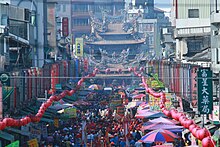Chaotian Temple
| Chaotian Temple | |||||||||||

Chaotian Temple during the week-long birthday celebrations for Mazu in 2009.
|
|||||||||||
| Simplified Chinese | |||||||||||
|---|---|---|---|---|---|---|---|---|---|---|---|
| Literal meaning | Facing-Heaven Palace | ||||||||||
|
|||||||||||
| Transcriptions | |
|---|---|
| Standard Mandarin | |
| Hanyu Pinyin | Cháotiān Gōng |
| Southern Min | |
| Hokkien POJ | Tiâu-thian-kiong |
The Chaotian or Chaotien Temple, officially the Chao-Tian Temple, is a temple to the Chinese sea-goddess Mazu in Beigang Township, Yunlin County, Taiwan. Constructed in 1700, it became one of the most important Mazu temples in Taiwan and is known for its extravagant temple architecture. It is visited by more than a million pilgrims every year.
Mazu, the deified form of the medieval Fujianesse teenager Lin Moniang, has an enthusiastic following on Taiwan. Beigang was one of the most important Taiwanese ports in the 17th century. As Beigang and its economy grew, at the same time the temple grew and expanded. Today the Chaotian Temple at Beigang is an important religious site and pilgrimage destination. Beigang's Mazu tours to other Mazu temples through whole Taiwan every year for visits and inspections.
In 1694, a monk requested that a statue of Mazu be brought to Beigang from the Chaotian Temple in her hometown of Meizhou in Fujian. In 1700, Chen Li-Shum donated a building lot and raised the funds to erect Beigang's own Chaotian Temple. In 1730, the temple was further expanded. In 1770, Penkang Magistrate Hsueh Chao-heng considered that the temple too simple to live up to the dignity of Goddess Matsu. Three years later another reconstruction of the temple started. In 1854 a number of ranking officials initiated a third project, expanding the temple into a palace-type architectural complex. The front wing consisted of worship courtyard and east and west chambers. The second wing was for worship of the Heavenly Mother, third wing for Goddess of mercy; east wing for San-Kuan Heavenly Emperors, west wing for Wenchang God, the 4th wing for Goddess Matsu's parents; east wing for Goddess of Childgiving and west wing, Lang God. Several renovation followed in the 20th century.
...
Wikipedia
